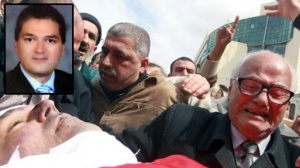
 Al-Haq has compiled information and affidavits collected by its field research team regarding the fatal shooting of the Jordanian Judge Raid Aladdin Zuaiter. Zuaiter was killed by Israeli soldiers at the first inspection point at the Karamah crossing (Allenby Bridge) on 10 March 2014. A number of testimonies were collected from eyewitnesses that crossed into the West Bank on the same bus as Judge Raid Zuaiter and were close to the victim at the time of the shooting. In addition, Al Haq researchers carried out an analysis of the scene where the incident took place.
Al-Haq has compiled information and affidavits collected by its field research team regarding the fatal shooting of the Jordanian Judge Raid Aladdin Zuaiter. Zuaiter was killed by Israeli soldiers at the first inspection point at the Karamah crossing (Allenby Bridge) on 10 March 2014. A number of testimonies were collected from eyewitnesses that crossed into the West Bank on the same bus as Judge Raid Zuaiter and were close to the victim at the time of the shooting. In addition, Al Haq researchers carried out an analysis of the scene where the incident took place.
After studying and verifying the information collected, Al-Haq has arrived at the following conclusions.
- At approximately 8:30 am a bus carrying passengers across the Jordanian-Palestinian border into the West Bank arrived at the first Israeli inspection point, located near the Jordan River. The bus stopped near a small yard, surrounded by a steel fence with two entrances. Israeli soldiers ordered the passengers to leave the bus and enter the yard, without taking any luggage with them whatsoever. A soldier then boarded the bus to inspect it. The passengers were only allowed to board the bus again after the soldier has finished the inspection.
- As the bus was being searched, a number of soldiers stood observing the passengers at a distance of 3-5 meters. In addition, some Israeli security officers were located in a room to the side of the passengers’ waiting yard.
- When the passengers were told they could return to the bus, they walked towards it and began boarding it. Meanwhile, Judge Zuaiter was standing near the front of the bus and another person was standing near the rear door, both of whom were smoking cigarettes. A woman and her child also remained outside the bus, waiting for her other child to finish usingIn total, there were five remaining passengers that had not yet boarded the bus. At this first security point, it is common for passengers to use the time in which the bus is searched to smoke, as they are forbidden from smoking both on the bus itself and at the Jordanian departure station. For this reason, a number of ashtrays are provided.
- The woman who had been waiting for her child was beside the front door of the bus, approximately one metre away from Judge Zuaiter. She witnessed the soldier that had carried out the inspection push the judge for being late to board the bus. Judge Zuaiter pushed the soldier back and the two scuffled for a while, but remained in a standing position.
- Immediately, two other soldiers joined the first soldier and the three of them pushed Judge Zuaiter onto the ground in front of the bus and then stepped back. The judge then stood up and started shouting and protesting against his treatment, with his hands raised in the air, walking towards the soldiers.
- At that point, according to the eyewitnesses, the soldiers pointed their guns at the judge, who was around 3-4 meters away from them. A shot was heard, followed by three others. The judge’s body shook as he was hit with the bullets and he was thrust backwards, before falling to the ground.
- At that point, the bus driver entered the bus and closed the doors. Shortly after, an Israeli soldier approached the Jordanian bus driver and requested that he ask the passengers to disembark from the bus one by one, which they did. Men and youths were made to lie on the ground face-down. Body searches were conducted on all of the passengers. Women were searched while standing up; their bodies were patted, with particular attention paid to their legs. In some instances, women were asked to open their jackets. All passengers disembarked from the bus for the search, after which the soldiers ordered them to return to the bus.
- During this period, the body of Judge Raid Zuaiter was still lying on the ground and none of the soldiers had examined it to determine if he was still alive.
- Minutes later, the soldiers returned to the bus and ordered the passengers to disembark once again and walk to a steel gate (located opposite the first inspection point, where Judge Zuaiter was shot). This is the border gate from which passengers depart to cross the border into Jordan. The soldiers ordered the bus driver to reverse approximately 20 meters.
- At that point, according to eyewitnesses, Israeli soldiers, police and paramedics in white uniforms arrived at the scene. Passengers saw them trying to revive Judge Zuaiter by pressing on his chest. Afterwards, they wrapped the corpse in a sheet.
- Almost an hour after Judge Zuaiter was shot, a soldier asked the passengers to come forward in groups of five and take their luggage onto another bus, after it had been inspected. As one of the eyewitnesses was opening his luggage for inspection, an Israeli intelligence officer came and asked him what had happened. The eyewitness informed him of what happened, telling him that an altercation had taken place between the judge and the soldiers, which developed into a scuffle, after which the Israeli soldiers shot Judge Zuaiter.
- Following this, the soldiers concluded the luggage search and ordered the passengers to move their luggage from the first bus onto another bus, which was waiting for them. One military jeep was parked in front this bus and a second jeep was parked at the rear of the bus.
- After the passengers had taken their luggage from the first bus onto the second, a soldier boarded the bus and asked if anyone had forgotten any luggage. He instructed the passengers to look out of the bus window at the remaining pieces of luggage. After the passengers confirmed that none of the remaining luggage belonged to them, the soldier advised the passengers not be afraid should they hear an explosion, as an explosive expert had arrived at the scene. The bus was then escorted to the arrival hall allocated for buses carrying passengers arriving from Jordan.
- After the Israeli authorities had taken their witness statements regarding the incident, the passengers crossed over the border and completed the procedure for entrance into the West Bank.
Conclusions:
The circumstances and context of the killing of Judge Raid Zuaiter reveal the following:
- The Israeli soldiers demonstrated a clear intent to inflict serious bodily harm and an extreme reckless disregard for the value of human life. The soldiers had the capacity to deal with Judge Raid Zuaiter’s protest against the soldiers’ insult and mistreatment of him by alternative means, including by his arrest. It was also clear to the soldiers that he was not in possession of anything that might have threatened or endangered their lives, especially owing to the fact that he was approximately three meters away from them at the moment of shooting and was clearly visible. Furthermore, prior to the incident, the judge was standing close by to the soldiers and they therefore would have been aware had he been in possession of anything that could be construed as suspicious, or that might pose a risk to their lives.
- Even if we accept that Judge Raid Zuaiter posed a real risk when he stood up from the ground, the soldiers could have shot him in the leg to restrict his movement instead of shooting four times in the thigh and the pelvis, especially given that the shots were fired with an automatic machine gun at a very close distance.
- The fact that more than one soldier simultaneously opened fire at the victim, without any prior warning - as is required pursuant to Israeli military codes of conduct for engagement and use of live fire and use of force by law enforcement officials - demonstrates the soldiers’ reckless disregard for the value of civilian life and further indicates the existence of orders permitting Israeli soldiers to commit such acts.
- The delay in the arrival of paramedic teams, who only reached the victim after approximately 20 minutes had passed, despite the fact that they were stationed at the crossing at the time of the incident, indicates the indifference of the Israeli personnel in charge of the crossing with regards to the life and fate of the victim. The gross negligence exhibited in allowing the victim to bleed to death further demonstrates an extreme reckless disregard for life.
- Contradicting accounts of the incident have been voiced by the Israeli authorities, including one allegation that Judge Zuaiter attempted to disarm one of the soldiers at the crossing and another that he attempted to attack the soldiers standing guard with an iron bar. In addition, the Israeli authorities have asserted that the security cameras were not functioning at the time of the incident, making it impossible to verify their accounts. These contradictory and unverified accounts attest to the Israeli authorities’ attempt to protect Israeli soldiers from being held accountable for their actions, allowing them to act with impunity and evade responsibility and punishment where it is due. The aforementioned allegations by the Israeli authorities also illustrate a practice of justifying soldiers’ actions rather than pursuing justice and ensuring accountability for unlawful actions.



 Al-Haq has compiled information and affidavits collected by its field research team regarding the fatal shooting of the Jordanian Judge Raid Aladdin Zuaiter. Zuaiter was killed by Israeli soldiers at the first inspection point at the Karamah crossing (Allenby Bridge) on 10 March 2014. A number of testimonies were collected from eyewitnesses that crossed into the West Bank on the same bus as Judge Raid Zuaiter and were close to the victim at the time of the shooting. In addition, Al Haq researchers carried out an analysis of the scene where the incident took place.
Al-Haq has compiled information and affidavits collected by its field research team regarding the fatal shooting of the Jordanian Judge Raid Aladdin Zuaiter. Zuaiter was killed by Israeli soldiers at the first inspection point at the Karamah crossing (Allenby Bridge) on 10 March 2014. A number of testimonies were collected from eyewitnesses that crossed into the West Bank on the same bus as Judge Raid Zuaiter and were close to the victim at the time of the shooting. In addition, Al Haq researchers carried out an analysis of the scene where the incident took place.